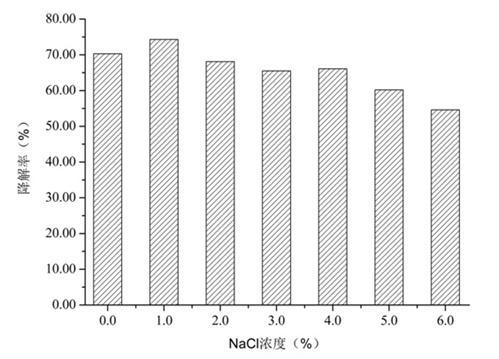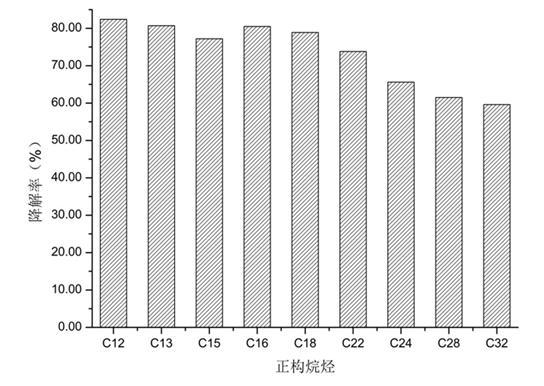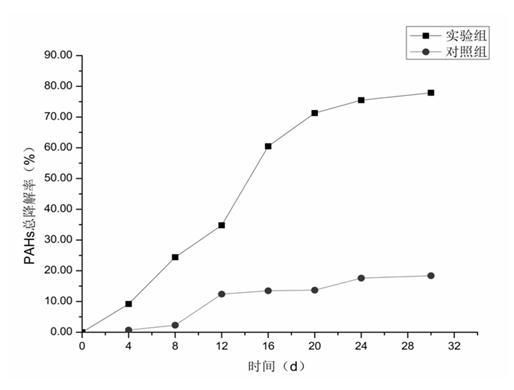Ralstoniasp. and application thereof in bioremediation of petroleum-contaminated saline-alkali soil
A technology of bacterial strains and microbial strains, applied in the restoration of contaminated soil, methods based on microorganisms, microorganisms, etc., can solve the problems of few studies on halophilic bacteria
- Summary
- Abstract
- Description
- Claims
- Application Information
AI Technical Summary
Problems solved by technology
Method used
Image
Examples
Embodiment 1
[0029] Isolation and screening of Ralstonia sp. XB strain provided by the invention.
[0030] Take 1g of oil-contaminated saline-alkali soil sample from the Yellow River Delta, and inoculate it into 100ml of inorganic salt liquid wax medium aseptically. Medium composition: Na 2 HPO 4 1.5g; KH 2 PO 4 3.48g; MgSO 4 0.7g; (NH 4 ) 2 SO 4 4g; yeast powder 0.01g; liquid paraffin 2% (v / w), distilled water 1000ml; pH under natural conditions; The enriched culture solution was thoroughly mixed, 100 μl was taken and spread on a 1.5% LB solid plate, cultured in a constant temperature incubator at 30° C. for 2-3 days, and the grown colonies were observed. Single colonies were picked and checked for purity using a microscope. Each grown colony was inoculated into LB medium and cultivated to OD 630 It is about 0.8, and it is inserted into 100ml of inorganic salt liquid wax medium as a seed solution at a ratio of 10% (v / v), and cultured with reciprocating shaking on a shaker a...
Embodiment 2
[0033] PCR Amplification and Sequence Determination of 16SrDNA Gene of Ralstonia sp. XB Strain
[0034] CGMCC No.3389 was inoculated in LB medium, cultured on a shaker at 30°C (130rpm) for 16 hours, collected by centrifugation, resuspended, added lysozyme and SDS to break the wall, extracted genomic DNA by phenol-chloroform method, and used positive phase primers 27F (5'-GAG AGTTTGATCCTGGCTCAG-3') and reverse primer 1541R (5'-AAG GAG GTG ATC CAG CC-3'), use this pair of primers for PCR amplification of its 16S rDNA gene, and send the amplification primers to Beijing Sanbo company for sequencing. The PCR conditions are: 94°C, 10min; 94°C, 45s, 55°C, 45s, 72°C, 90s, 30 cycles; 72°C, 10min, 4°C storage. The length of the 16S rDNA gene sequence is 1488bp, and the sequence similarity with Ralstonia pickettii strain ATCC 27511 (Accession No. AY741342) is 99%. The sequence of its 16S rDNA is shown in the sequence listing.
Embodiment 3
[0036] Degradation of polycyclic aromatic hydrocarbons (PHAs) by Ralstonia sp. XB strain at different NaCl concentrations
[0037] Get the fresh slant strain of this bacterial strain, inoculate an inoculation loop in the Erlenmeyer flask that 100ml containing the inorganic salt culture medium (substrate composition is the same as embodiment 1) of naphthalene, anthracene, phenanthrene and pyrene each 50mg / L is housed, cultivate 0-5% NaCl was added to the base, cultured on a shaker at 30°C (130rpm) for 7 days, and the degradation rate of polycyclic aromatic hydrocarbons (PHAs) was determined by gas chromatography (GC method). The results are as follows figure 1 As shown, the degradation rate of strain XB to naphthalene can reach 92.1%, and in the presence of 5% NaCl, the degradation rate is still 14.2%; the degradation rate of anthracene can reach 57.8%, and in the presence of 5% NaCl, the degradation rate decreases. The degradation rate of phenanthrene can reach 87.4%. With the...
PUM
 Login to View More
Login to View More Abstract
Description
Claims
Application Information
 Login to View More
Login to View More - R&D
- Intellectual Property
- Life Sciences
- Materials
- Tech Scout
- Unparalleled Data Quality
- Higher Quality Content
- 60% Fewer Hallucinations
Browse by: Latest US Patents, China's latest patents, Technical Efficacy Thesaurus, Application Domain, Technology Topic, Popular Technical Reports.
© 2025 PatSnap. All rights reserved.Legal|Privacy policy|Modern Slavery Act Transparency Statement|Sitemap|About US| Contact US: help@patsnap.com



